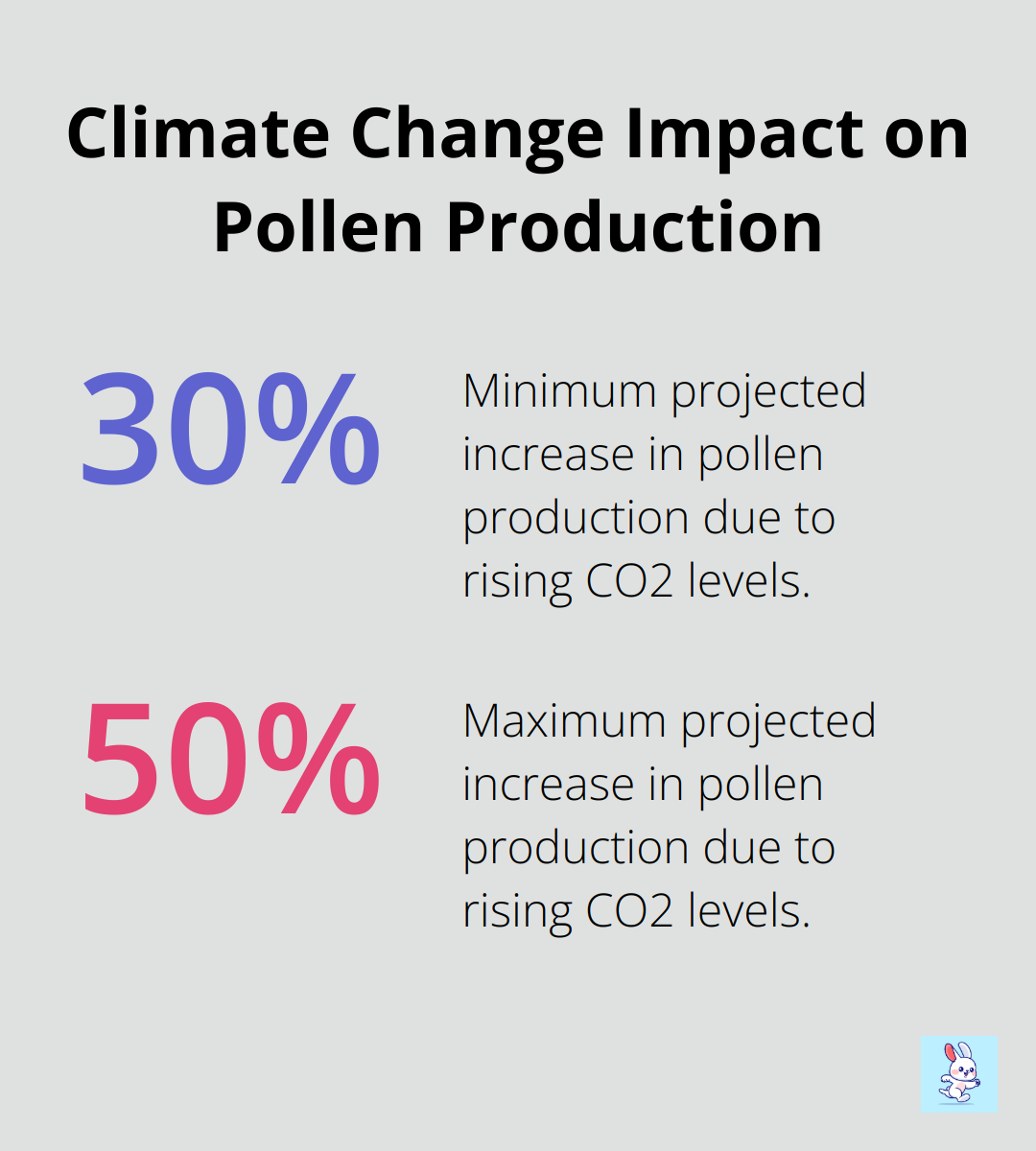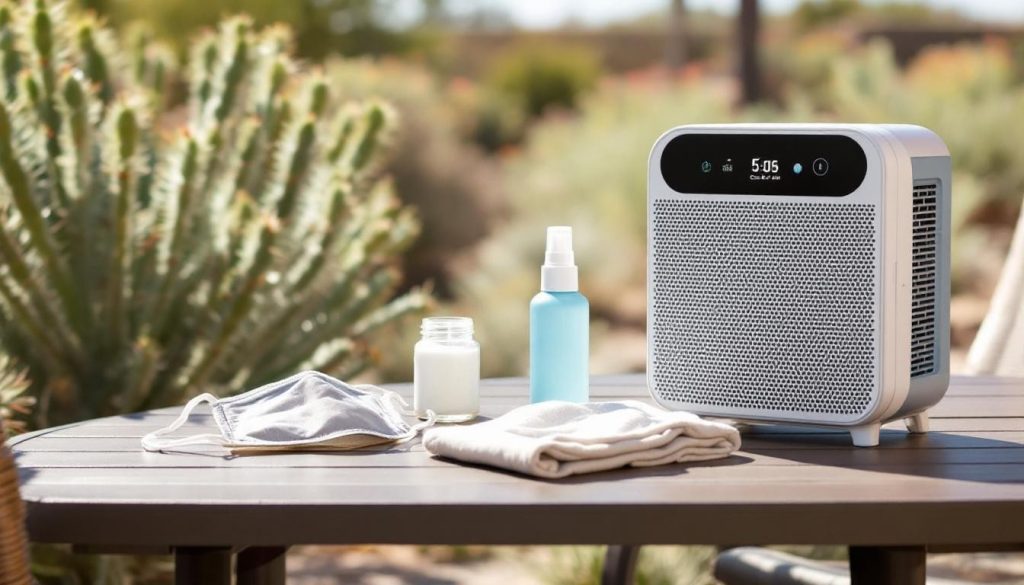Seasonal allergies can turn Nevada’s beautiful landscapes into a challenging environment for many residents. At Cleaning Rabbit, we understand the impact these allergies have on your daily life and overall well-being.
This blog post explores effective seasonal allergies solutions, focusing on improving indoor air quality as a key strategy. We’ll dive into Nevada’s unique allergen profile and provide practical tips to help you breathe easier in your home.
What Triggers Allergies in Nevada?
Nevada’s Unique Allergy Landscape
Nevada’s distinct climate and geography create a challenging allergy environment for residents. Las Vegas and Henderson, despite their desert surroundings, host several pollen-producing plants that cause significant allergy issues.
The main allergy triggers in Nevada include:
- Mulberry, olive, and ash trees (pollen release: February to May)
- Bermuda grass (peak pollen: May to July)
- Ragweed and Russian thistle (problematic: August to November)
The National Allergy Bureau consistently ranks Las Vegas among the top 100 most challenging places to live with allergies in the United States. High winds in the region can carry pollen for miles, increasing exposure even in urban areas.
Seasonal Patterns in Las Vegas and Henderson
Allergy seasons in Las Vegas and Henderson follow a predictable pattern, though their intensity varies year to year:
- Spring allergies: Late February to early June (primary culprit: tree pollen)
- Summer allergies: June through August (dominated by grass pollen)
- Fall allergies: Late August to first frost (mainly weed pollen)
In Las Vegas, the first frost often doesn’t occur until December, potentially extending the fall allergy season.
Climate Change Impact on Allergies
Climate change alters allergy patterns in Nevada. Rising temperatures and carbon dioxide levels are contributing to increased pollen production and potentially more allergenic pollen.
A study in the Proceedings of the National Academy of Sciences found that the ragweed pollen season has extended by up to 27 days in some parts of North America due to climate change. For Nevada, this translates to longer and potentially more severe fall allergy seasons.
Moreover, increased CO2 levels cause plants to produce more pollen. Research from the University of Massachusetts Amherst shows that pollen production can increase by 30-50% under projected future CO2 levels, potentially leading to more intense allergy symptoms for Nevada residents.

Preparing for Nevada’s Allergy Seasons
Understanding these patterns and changes helps you prepare for and manage your allergies effectively. You can time your outdoor activities and enhance your indoor air quality measures based on Nevada’s allergy landscape.
As we move forward, we’ll explore how indoor air quality affects allergy symptoms and what you can do to create a healthier home environment. The connection between air quality and allergies is crucial in developing effective strategies to combat seasonal discomfort.
How Indoor Air Quality Affects Your Allergies
The Indoor Allergen Trap
Your home can harbor various allergens that trigger symptoms. Dust mites, pet dander, mold spores, and pollen that sneaks in from outside are common culprits. These allergens often accumulate in carpets, upholstery, and bedding.
The Environmental Protection Agency found that indoor air quality can be improved through source control, ventilation, and filtration to reduce exposure to indoor pollutants. This fact is particularly concerning for allergy sufferers in Nevada, where people spend up to 90% of their time indoors to escape the heat.
HVAC Systems: Double-Edged Sword
Your HVAC system plays a dual role in indoor air quality. While it can help filter out allergens, it can also circulate them if not properly maintained.
A dirty air filter can become a breeding ground for mold and bacteria. The American College of Allergy, Asthma & Immunology reports that a clogged filter can reduce airflow by up to 15% (decreasing your HVAC system’s efficiency and its ability to clean your air).
Regular HVAC maintenance is essential. The U.S. Department of Energy recommends changing your air filter every 1-3 months, depending on usage and the presence of pets or smokers in the home.

The Hidden Impact of Humidity
Nevada’s dry climate might seem beneficial for allergy sufferers, but indoor humidity levels can still pose problems. Low humidity can dry out nasal passages, making them more susceptible to irritation from allergens.
Conversely, areas of high humidity in your home (like bathrooms or basements) can foster mold growth. When outdoor air at 10°F is heated to 70°F indoors, the humidity level in your home will be around 7%, which can cause dry skin.
The Role of Ventilation
Proper ventilation is key to maintaining good indoor air quality. Inadequate ventilation can lead to a buildup of allergens and pollutants. The American Lung Association recommends opening windows for short periods to allow fresh air circulation, especially during low pollen count days.
Air Purification Methods
Air purifiers can significantly reduce airborne allergens in your home. HEPA filters are particularly effective, capturing particles as small as 0.3 microns. Studies have shown that HEPA air purifiers can remove up to 99.97% of airborne particles, including many common allergens.
Addressing indoor air quality is a powerful strategy for managing allergies in Nevada. Understanding the sources of indoor allergens and the role of your HVAC system empowers you to take proactive steps. In the next section, we’ll explore specific methods to improve your indoor air quality and reduce allergy symptoms.
How to Improve Your Indoor Air Quality
Deep Clean Your Air Ducts
Air ducts can accumulate allergens, dust, and mold. Professional air duct cleaning can significantly reduce allergens in homes. In Las Vegas, there are several highly-rated air duct cleaning services available, such as All Ducts Cleaning and 1st Choice Air Duct Care.
Maintain Your HVAC System
Regular HVAC maintenance improves air quality. The Department of Energy recommends changing air filters every 1-3 months. Nevada’s dusty environment might necessitate monthly changes, especially during peak allergy seasons.
Don’t neglect your outdoor unit. A clean, debris-free unit ensures efficient operation and better air quality. Schedule professional HVAC maintenance at least once a year to keep your system performing optimally.
Address Hidden Allergen Sources
Dryer vents often become overlooked allergen sources. The U.S. Fire Administration reports that uncleaned dryer vents are the leading cause of home dryer fires. Clean vents improve air quality by preventing lint and dust circulation.
Annual professional dryer vent cleaning improves air quality and enhances your dryer’s efficiency (potentially lowering energy bills).
Use Effective Air Purification
Air purifiers can significantly help allergy sufferers. Choose models with True HEPA filters, which remove 99.97% of particles as small as 0.3 microns. The Asthma and Allergy Foundation of America recommends air purifiers in bedrooms and living areas for maximum benefit.
For whole-home solutions, install a high-efficiency filter in your HVAC system. MERV ratings of 11-13 typically suffice for residential use, balancing filtration with system efficiency.
Create an Allergy-Resistant Home
Simple changes in your daily routine can reduce indoor allergens:
- Use allergen-proof covers on mattresses and pillows.
- Wash bedding weekly in hot water (130°F or higher).
- Keep indoor humidity between 30-50% to prevent mold growth.
- Vacuum carpets and upholstery twice weekly with a HEPA-filter vacuum.
- Remove shoes at the door to avoid tracking in outdoor allergens.
The American Academy of Allergy, Asthma & Immunology found that these measures can reduce dust mite allergens by up to 90%.

Final Thoughts
Managing seasonal allergies in Nevada requires a comprehensive approach that focuses on improving indoor air quality. Regular maintenance of your HVAC system, including air duct cleaning and filter changes, removes accumulated allergens and ensures efficient operation. Incorporating air purification methods, such as HEPA filters and whole-home air purifiers, further reduces airborne allergens in your living spaces.
Professional air quality services play a vital role in combating seasonal allergies. Cleaning Rabbit offers expert air duct cleaning, dryer vent cleaning, and HVAC sanitation services in Las Vegas and Henderson. Our team uses state-of-the-art HEPA-filtered equipment to provide thorough and effective solutions for improving your home’s air quality.
The benefits of maintaining clean indoor air extend beyond allergy relief. Improved air quality leads to better overall health, increased energy efficiency, and a more comfortable living environment. Implementing these seasonal allergies solutions and seeking professional help when needed will allow you to enjoy Nevada’s beautiful seasons with fewer allergy symptoms (and breathe easier in your home).

